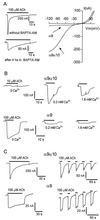alpha10: a determinant of nicotinic cholinergic receptor function in mammalian vestibular and cochlear mechanosensory hair cells
- PMID: 11248107
- PMCID: PMC30682
- DOI: 10.1073/pnas.051622798
alpha10: a determinant of nicotinic cholinergic receptor function in mammalian vestibular and cochlear mechanosensory hair cells
Abstract
We report the cloning and characterization of rat alpha10, a previously unidentified member of the nicotinic acetylcholine receptor (nAChR) subunit gene family. The protein encoded by the alpha10 nAChR subunit gene is most similar to the rat alpha9 nAChR, and both alpha9 and alpha10 subunit genes are transcribed in adult rat mechanosensory hair cells. Injection of Xenopus laevis oocytes with alpha10 cRNA alone or in pairwise combinations with either alpha2-alpha6 or beta2-beta4 subunit cRNAs yielded no detectable ACh-gated currents. However, coinjection of alpha9 and alpha10 cRNAs resulted in the appearance of an unusual nAChR subtype. Compared with homomeric alpha9 channels, the alpha9alpha10 nAChR subtype displays faster and more extensive agonist-mediated desensitization, a distinct current-voltage relationship, and a biphasic response to changes in extracellular Ca(2+) ions. The pharmacological profiles of homomeric alpha9 and heteromeric alpha9alpha10 nAChRs are essentially indistinguishable and closely resemble those reported for endogenous cholinergic eceptors found in vertebrate hair cells. Our data suggest that efferent modulation of hair cell function occurs, at least in part, through heteromeric nAChRs assembled from both alpha9 and alpha10 subunits.
Figures




References
-
- Hudspeth A J. Nature (London) 1989;341:397–404. - PubMed
-
- Fuchs P A. Curr Opin Neurobiol. 1996;6:514–519. - PubMed
-
- Guth P S, Norris C H. Hear Res. 1996;98:1–8. - PubMed
-
- Warr W B. Organization of Olivocochlaer Efferent Systems in Mammals/The Mammalian Auditory Pathway: Neuroanatomy. New York: Springer; 1992.
-
- Guinan J J, Jr, Stankovic K M. J Acoust Soc Am. 1996;100:1680–1690. - PubMed
Publication types
MeSH terms
Substances
Associated data
- Actions
- Actions
- Actions
Grants and funding
LinkOut - more resources
Full Text Sources
Other Literature Sources
Molecular Biology Databases
Miscellaneous

